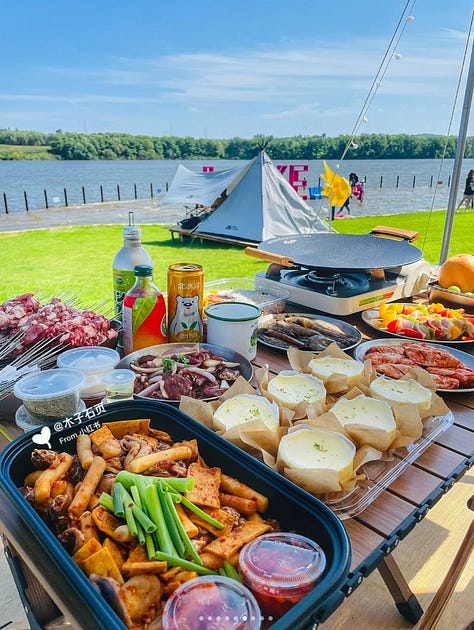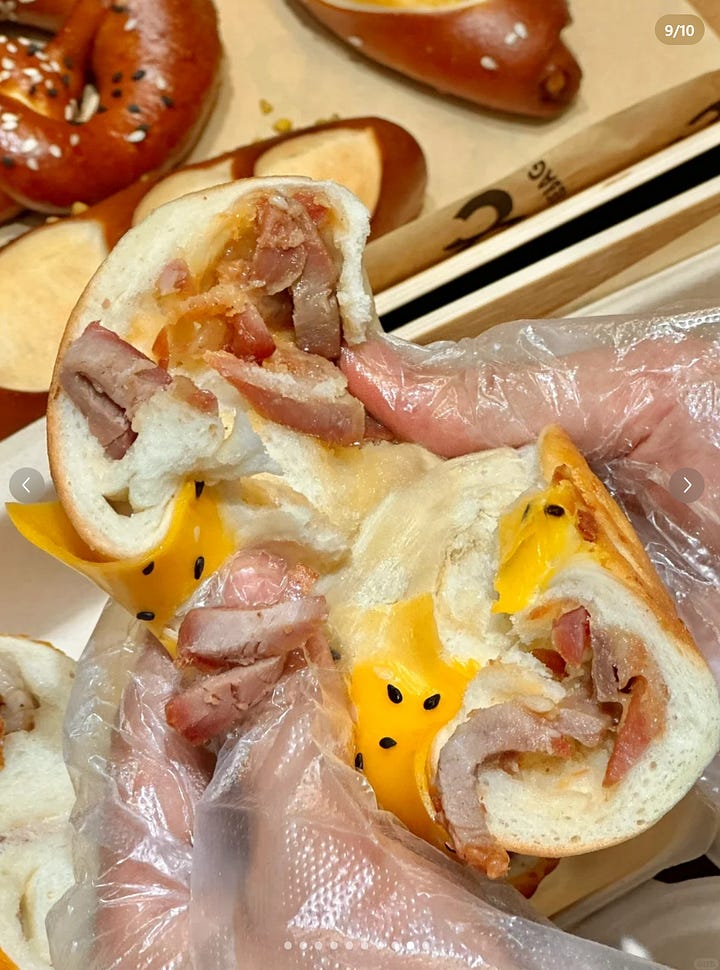Chinese Bagels (贝果)
In 2024? One of the trendiest Chinese snacks is... the Bagel. And it's not exactly the same as what you'd find in New York.
Click here to jump to the recipe.
One of the ‘trendiest’ baked goods in China these days is… the bagel. The popularity began ramping up during the COVID years, and as of late, they’ve firmly planted themselves in the Chinese bakery scene. It’s a breakfast, it’s a snack. You can see students with a bagel under their arm rushing to their next class; you can find it as a popular addition to Chinese ‘picnics’ (i.e. hanging out in a park with a tent with friends and family).



They’re stuffed. They’re technicolor. They’re… squishy.
Among some expats circles in China, we used to - sort of dismissively - refer to these as ‘Chagels’. After all, if you’re from North America (and a little homesick), you don’t want your bagel to bend when you try to apply cream cheese; you’re not really in the market for something stuffed with shrimp, cheese, and broccoli.
But over the years, as bagels move from niche to mainstream, I began to develop an appreciation for ‘the Chagel’. It’s its own thing, its own style. In a world where there’s German bagels, New York bagels, Montreal bagels… why not a Chinese bagel too?
But I suppose we need to explain a bit how we got to this point.
The landscape of western-style bakeries in China
When you hear the words “Chinese food”, probably… “bread” isn’t exactly the first thing that might pop to mind.
And certainly, the multitude of bakeries that you’ll see today across (especially coastal) China is undeniably a western import. But before we delve into how that happened, I do think it bears emphasizing that China also has its own rich tradition of baked goods. Bread and bagel making did not arrive on virgin land – they stepped into a culture that had been developing gluten for noodles and baking mooncakes for millennia.
Still, the first western-style breads came to China in the late 19th century via Hong Kong style bakeries. And what started as a way to feed the increasing number of British colonists, over the years began to morph and develop a distinctly Cantonese style. If you live in a city with an extensive Chinatown in the west, you might’ve actually bumped into these sorts of bakeries before: they tend to serve up a mix of traditional fare (e.g. steamed buns) together with Cantonese favorites like Egg Tarts, Bean paste stuffed breads, and Pineapple and Hot Dog buns:
The second big wave of Western style bakeries came, then, to the mainland post-WTO entrance in the form of Taiwan-style bakeries. This happened at first via large chains like 85 degrees, but these days there are plenty of more mom and pop operations as well.
Taiwan style bakeries could sort of be thought of as an offshoot of Japanese style bakeries. They’ll often include items that you could find at a traditional Cantonese bakery (e.g. hot dog buns), but they also include the distinctly Japanese mainstays of Shokupan, fluffy cheesecakes, etc etc. These are, at present, still the most common bakery that you can find in China.
But in recent years, there’s started to be what we consider to be a ‘third wave’ of Chinese bakeries – this time a bit more directly western inspired:
The western expatriate is bound to be a bit more at home with one of these in their neighborhood. There’s… croissants. Ciabatta bread. Pretzels. All of which are made reasonably to spec to what you might find in the west. What you’ll also usually find in this style of bakery as well however, is a clientele that’s more-or-less… under the age of 30.
You see, I think it’s pretty common knowledge that throughout the 00s and 10s – and even up to today – large swaths of Chinese university students went to the USA, Canada, Australia, and the UK to study. But much less well internalized in people’s heads, I think, is that after graduation that swath of students, by and large, would return to China (after all, it’s not like USCIS is exactly clamoring for large groups of foreign students to stay and try to join the workforce).
But with them? They’ve helped bring back a culture of Western-style microbrews, trendy coffeeshops complete with single source pour-overs, and… bakeries.
These bakeries, however, often end up as mutts of sorts. After all, while those that study abroad are from a rather culturally powerful block (upper middle to upper class families, often from coastal China), they’re still - comparatively speaking – a rather small group as a percentage of the total population. So what you’ll usually find is a layering of these three waves: Cantonese hot dog buns next to the Japanese Shokupan, all next to the German-style Pretzels.
And perhaps nowhere is this layering of Chinese, Japanese, and western styles clearer than with… the Chagel.
The Bagel: from New York, to Japan, to Shanghai
Because we do need to be clear here: an enormous chunk of the modern bagel tradition you can find in China today is quite obviously Japanese in origin. Like… Japanese bagels are also stuffed. They’re also technicolor, and they’re also quite squishy.


They’re shaped in the same way, they’re stuffed in the same way… they’re even sandwich-ified in the same way.
Because for many of my years in China? Bagels weren’t exactly a popular menu item. You’d see them pop up here or there at some of the most authentically western of the western-style bakeries (expatriate run joints and the like), but they hadn’t hit the cultural mainstream quite yet. In the end, it was applying some of that Japanese technique that really caused them to take off.
And yet, the form of bagel that you see in China today isn’t exactly the same as their Japanese counterparts:
Japanese bagels are practically outrageously soft – almost like a chewy bread in bagel form. Chinese bagels, meanwhile, develop the gluten a bit more intensely, and also seem to be a bit less aggressive with the final proofing. The final texture is something that’s about halfway between a Japanese style bagel and a western style bagel, hitting a similar sort of fluff and chew as a northern-style mantou.
Further, as the years tick by, the fillings themselves seem to be getting increasingly… sinified. While much of the bagel scene in Asia could be thought of as an amorphous, nebulous cauldron of creative and outlandish fillings, interestingly in China you can start to see a number of bother sweet and savory fillings that wouldn’t be totally out of place inside of a Baozi. Mala sausage? Sure. Pork and Chinese sauerkraut? Of course. Black sesame – obviously.




So in this post, we’ll cover the Chinese bagel itself, together with three fillings:
A triple cheese stuffed filling, which is a popular bagel choice throughout Asia
A unique Chinese savory filling in the form of red braised pork
A sweet filling, using purple sweet potato
How to Make Chinese Bagels
This recipe is designed to be scaled up, or down.
The dough quantities are for eight bagels, ditto with the stuffing quantities.
Do note that the stuffing quantities listed below are higher (four times higher, to be exact) than the accompanying video, as in the video we we making four different flavors for our eight bagels.
Ingredients:
For the dough [baker’s percentages are in brackets for your reference]:
Bread flour (高筋面粉), 480g
Water, 278g [58%]
Salt, 10g or 2 tsp [2%]
Honey (蜂蜜), 25g [5%]
Yeast (酵母), 5 or 1 tsp, dissolved with 5g water [1%]
If you live in a hot, tropical climate (i.e. room temperature 28C-32C), cut the yeast quantity in half.
For the Triple Cheese Bagel:
Parmesan cheese, 32g. Shredded, to be mixed in with the dough.
Cheddar cheese, 64g. Cut into 1cm cubes.
American cheese, 8 slices.
For the Red Braised Pork Bagel:
Pork belly (五花肉), 280g. Cut into a 2cm dice.
Oil, 3 tbsp
Sugar, 2 tbsp
Ginger (姜), ~1 cm piece
Scallion white (葱白), from ~2 sprigs
Hot water, 1 1/3 cups
Liaojiu, aka Shaoxing wine (料酒), 1 tsp
Soy sauce (生抽), 2 tsp
Dark soy sauce (老抽), 1 tsp
Five spice powder (五香粉), 1 tsp
Salt, 1/2 tsp
MSG (味精), 1/2 tsp
Cornstarch (生粉) 2 tsp. Mixed in with 2 tbsp water to make a slurry.
For the purple sweet potato bagel:
Fine brown sugar (细红糖) or molasses (糖蜜), 28g. To be mixed in with the dough.
Purple sweet potato (紫薯), 280g
Water, 1/4 cup
Sugar, 25g or 4 tsp
Butter, 25g or 2 tbsp melted
Sweetened condense milk (炼奶/炼乳), 40g or 1/4 cup.
For the final boil:
Water, 1 liter
Granulated sugar, 1 tbsp
Process:
To prepare the red braised pork filling (if using):
Over a low flame, fry the sugar in with the oil for 2-3 minutes to melt it slightly. Add in pork belly, ginger and scallion white, fry until browned, 4-5 minutes. Add the hot, boiled water, together with the wine, the soy sauce, the dark soy sauce, and the five spice powder. Cook on low heat until the sauce has reduced to only about 1/2 cup, ~15 minutes. Season with salt and MSG, then thicken with the cornstarch slurry. Set aside to cool down.
To prepare the sweet potato filling (if using):
Peel and cut the sweet potato, arrange it into a layer on a plate, add water, cover and microwave on medium high for 4 minutes. With this quantity, you may need to work in batches. Mash in the sugar, the melted butter, and the sweetened condensed milk.
Phase 1: Making the base dough.
Combine flour and water and mix into a rough ball. Cover, and set aside in a cool place to autolyze for 45 minutes.
Cut the dough in smaller pieces, mix in the salt, honey, and yeast. If going the cheese route, also add in the cheese; the sweet potato, the brown sugar. Knead until everything is combined, and the dough is no longer sticking to your hands, 3-5 minutes.
Use the slap and fold method (if needed, go to 3:26 in the video for a visual on how to slap and fold), slap for about 150 times, or until you can get a hole with a smooth-ish ring for the windowpane test.
Phase 2: Shaping and stuffing.
Divide the dough in eight, for eight bagels. Shape into a ball (if needed, go to 4:24 in the video for a visual on how to shape into a ball). Cover and rest for 20 minutes.
Roll each ball into a very rough ‘rectangle’, roughly 18-20cm long and 15 cm wide (if needed, go to 5:14 in the video for a visual of how to shape into a rectangle).
Press down along the far length of the rectangle to allow for easier sealing. If adding any fillings, add them along the near length of the rectangle, keeping at least 2cm from each edge. Roll everything up into a log. If you are going with the red braised pork filling, fold the sides in like a Christmas present before you roll to ensure the filling doesn’t leak.
Keeping the ‘seam’ side down, cover and rest the logs for 15 minutes.
Phase 3: Making the bagel ‘ring’.
Gently roll the logs out to about 20-25 cm, keeping the ‘seam’ side down.
Pinch one end into a sort of ‘fish tail’ shape. Take the other end, nuzzle it into the ‘fish tail’, and wrap the ‘fins’ around to high the connection. Pinch closed, hiding the seal at the bottom.
Work through all of the bagels, keeping the seam side down.
Proof for about one hour.
Phase 4: Boiling, topping, and baking
After proofing, the dough should slowly bounce back in 2-3 seconds when applying the poke test.
Assuming it’s at that point, bring a pot of about one liter of water up to a rapid boil, and mix in the tablespoon of sugar. Set a dry cloth and any toppings you might want next to your boiling station, and swap your flame to medium low. Keep the water at a simmer.
Boil the bagels for 30 seconds on each side. You will likely need to work in batches. Remove with a strainer or spider, drip off any excess water onto the cloth on the side. If adding bagel toppings (e.g. sesame seeds, etc etc), dip the bagel into your topping of choice. Place on a piece of parchment paper.
Bake in a 200C preheated oven for 15 minutes.
If adding making the triple cheese bagels, add the cheese immediately when it’s hot from the oven to let it melt.
At least rest for 20 minutes before eating.







We're diehard chewy bagelites, but still found your article and recipe seriously impressive. Such a lot of time and research went into them that we might actually give the recipe a swing. The instructions are so detailed and clear that the results seem almost guaranteed. We're thinking of starting with a 蔥油餅 version.
There are tons of Japanese croissant places here but this is the first time I’ve ever heard of a chagel. Hope they come to Toronto soon. My HK-Jewish family might be interested.